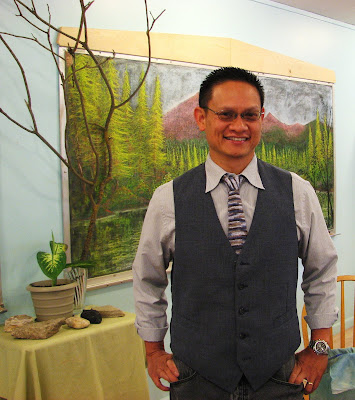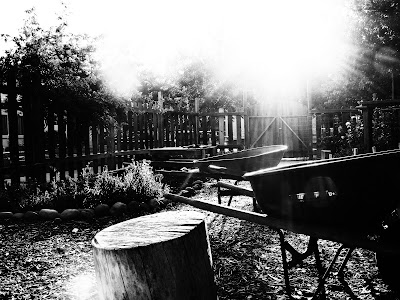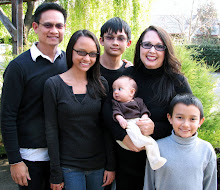and modern science
I wrote an essay for my phenomenology class at Steiner College. In short, phenomenology is an approach to science that studies the world through what we as humans can directly observe and experience. For instance, in studying nature, we must examine the plant as a whole, and in the parts we can see with our naked eyes. In so doing, we learn the true essence of the nature of the plant. In my essay, "Inward Spiral, Outward Spiral," I support the reductivist methodology of modern science while also encouraging the phenomenological approach. I think the combination of both gives us the little pictures and the big picture of our natural world.
Here is the essay. Enjoy!
In college, I took many classes for my biological sciences major that ended in –ology, such as biology, microbiology, bacteriology, anthropology, and zoology. In medical school, I had classes such as pharmacology and physiology. Clearly, we humans love to study things! These disciplines represent only a fraction of the sciences that exist out there today. And it seems new fields of science are developing each day. Combined with the other areas of human life such as sociology, geography, history, economics, mathematics, physics, computer sciences, language arts, music, arts, and crafts, it becomes evident that we really like to study things, to try and make sense of things, to try and figure out what life is all about, and to perhaps connect our lives with the larger cosmos.
Another field of study is phenomenology. Johann Wolfgang von Goethe followed the principles of phenomenology in his approach to studying nature. In studying nature through the lens of this discipline, he believes that we can find a connection to the cosmos and to the understanding of things. In the direct human experience of nature, through the “encountering” of nature with what physical senses we are endowed with and what inner intellect we have, the true essence of the object would reveal itself to us. He states, “Each phenomenon in nature, rightly observed, wakens in us a new organ of understanding.”
In studying nature, we need to cultivate the ability to let thoughts dissolve and experience, for instance, the plant kingdom as just the thing-in-itself. We need to be active in not doing, and allow the plant to speak. It would tell us all the mysteries of its life, and ultimately, the truths of existence. It is an elegant and beautiful view of the study of nature.
In the Waldorf classroom, in particular, the grades, where the teacher is appealing to the feeling life of the students, this phenomenological approach serves the teacher well in enlivening the curriculum. The child, whether as a first grader simply strolling through a wooded path or a seventh grader actively contemplating the phyllotaxy of Rosmarinus officinalis, the direct experience of the phenomena of nature is satisfying and life-affirming. It aids the teacher in fostering a love of learning that we all want for our children.
The interactive, phenomenological approach connects us to the elements, the tangible stuff that our world is made of and within which we experience the world in a very intimate way. Air, water, fire, and earth. Inspiration, imagination, intuition, and intellect. In the material elements are the human elements. For an eighth grade physics block, I was cognizant of actively approaching my lessons through a phenomenological lens. We studied the properties of heat by directly observing and experiencing the effects of fire, and the sun on our skin, on our clothing, on different materials, in a room. We studied magnetism, pressure, and even some physiology. But I come from a “traditional” science background, and I would say that my lessons were not purely phenomenological. While I did not formally engage the students in the scientific method, I still felt it important to include concepts such as refraction and reflection, convection and radiation, rays of incidence, etc., all products of the reductivist, 20th century approach to the sciences.
And this brings me to the title of this essay, “Inward Spiral, Outward Spiral.” There is validity in the phenomenological approach, and certainly, if our walk through the bio-dynamic garden, and our using our senses to learn about yarrow, agapanthus, sunflowers, and apples demonstrate this method, then it is a welcome approach – definitely more joyful than leaning over a microscope in a lab to look at a cross-section of xylem and phloem! But I feel a sense of obligation to defend the work of the great scientists of our time, who took the reductivist path to exploring and understanding the sciences. I believe that humans are young, relative to the history of the cosmos. It has been only about 10,000 years ago that human history had begun to be recorded, only about 1000 years ago that the scientific method was born, only about 100 years ago that human genetics was being studied, and only 10 years ago that the human genome was mapped.
The work of a multitude of really smart people, of so many minds working towards the betterment of humankind, lead to the advancements in the field of genetics and medical science. These advancements arose from reductivist science, not phenomenological science. In the eyes of Goethe, all the research going on in these medical laboratories are a “calamity,” that the “use of experiments has severed nature from man…microscopes and telescopes, in actual fact, confuse man’s innate clarity of mind.” But, I believe we need to give modern science a chance. Modern science is in a period of what I call the Inward Spiral.
Imagine the snail shell, and beginning at the outermost contour of the shell, one can trace a path that gradually spirals into a point more or less in the middle of the shell. Now imagine that a tiny human can walk along the contour of this shell. As the human is walking, he is seeing the world, and he is taking in the wonder of it all. At first, he is accepting, for example, the mysteries of the weather or his body as divine. As he walks the Inward Spiral, he develops questions that dig deeper and deeper, he makes observations, he creates experiments, he gathers data, he makes calculations, he creates more elaborate experiments, his measurements become more precise, he aids his senses with tools to gain new perspectives, his quest leads him to examine the parts of the whole, then the parts of the parts, then the parts of the parts of the parts. He goes from body, to cell, to nucleus, to chromosomes, to DNA sequences, to base pairs, to molecules, to elements, to atoms, to subatomic particles, to maybe even the “God” particle. This is the path of modern science, of the Inward Spiral.
We are at a moment in human history where we are walking the contour of the snail shell towards the middle of the spiral. What happens when we reach the endpoint?
We enter then into a new phase of human history, the Outward Spiral. Here, I think we as humans will have developed a deep understanding of the materiality and elementality of our existence that our course will then change. In using the intellectuality we were born with to gain the knowledge amassed during the Inward Spiral, we can walk with spirituality, with deep global citizenry, and with a holistic view. This is the Outward Spiral.
I think perhaps that we humans need to enter into the Inward Spiral to be able to actively, and rightly engage ourselves in the Outward Spiral. We are young, and we are still in the process of awakening our senses and our spirits. In the Outward Spiral, as I think some of our scientists have entered into, they are finding ways of healing our earth, curing diseases, and discovering the connectedness of the kingdoms. At the outermost contour of the Outward Spiral, we will discover the spirituality that will bring peace to all the world’s creatures and the universe.
Maybe the advocates of phenomenology have old souls that can already see with enlightened eyes. They may not need to enter into the Inward Spiral to experience the Outward Spiral to reach the cosmos.
David Seamon states in Goethe's Way of Science: A Phenomenology of Nature, “We must somehow find ways to bring our thoughts, feelings, and actions in harmony both with ourselves and with the world in which we live.”
I invite him to take a stroll along the Inward Spiral with me. We might spend some time in a research facility splitting an atom, but that stroll will also have time spent smelling the fragrant aroma of roses or jasmine, feeling the warmth of the sun, tasting the sweetness of a persimmon, and listening to the flow of a stream – the phenomena of our immensely amazing world.


















 As we hiked on trails, there were amazing views in all directions...
As we hiked on trails, there were amazing views in all directions... And lots of rocks.
And lots of rocks. This is on the way to Bumpass Hell.
This is on the way to Bumpass Hell.
 Oh, there they are!
Oh, there they are! Cinder Cone is a 750 foot tall cone volcano, whose steep climb is like
Cinder Cone is a 750 foot tall cone volcano, whose steep climb is like



























